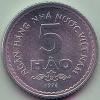Đại số affinoid
Một $k$-đại số $A$ được gọi là affinoid nếu tồn tại một toàn cấu $T_n(k) \twoheadrightarrow A$ của các $k$-đại số. Một toàn cấu như vậy gọi là một biểu diễn của $A$.
Từ các tính chất của đại số $T_n(k)$ mà ta có các tính chất sau của các đại số affinoid.
Cho $A$ là một $k$-đại số affinoid, khi đó:
- Mọi biểu diễn định nghĩa một metric trên $A$ theo ví dụ 1 và tô-pô sinh bởi metric này thực chất không phụ thuộc vào biểu diễn của $A$.
- Vành $A$ là noetherian.
- Vành $A$ là Jacobson.
- Tồn tại một đơn cấu hữu hạn $T_n(k) \hookrightarrow A$ với $n$ nào đó. Nói riêng, $n = \dim(A)$.
- Một ideal nguyên tố $\mathfrak{p}$ là cực đại khi và chỉ khi $A/\mathfrak{p}$ là mở rộng hữu hạn của $k$.
- Mọi ideal của $A$ đều đóng.
- Mọi $k$-đồng cấu đại số giữa các $k$-đại số affinoid là liên tục.



 Tìm kiếm
Tìm kiếm Không khai báo
Không khai báo














